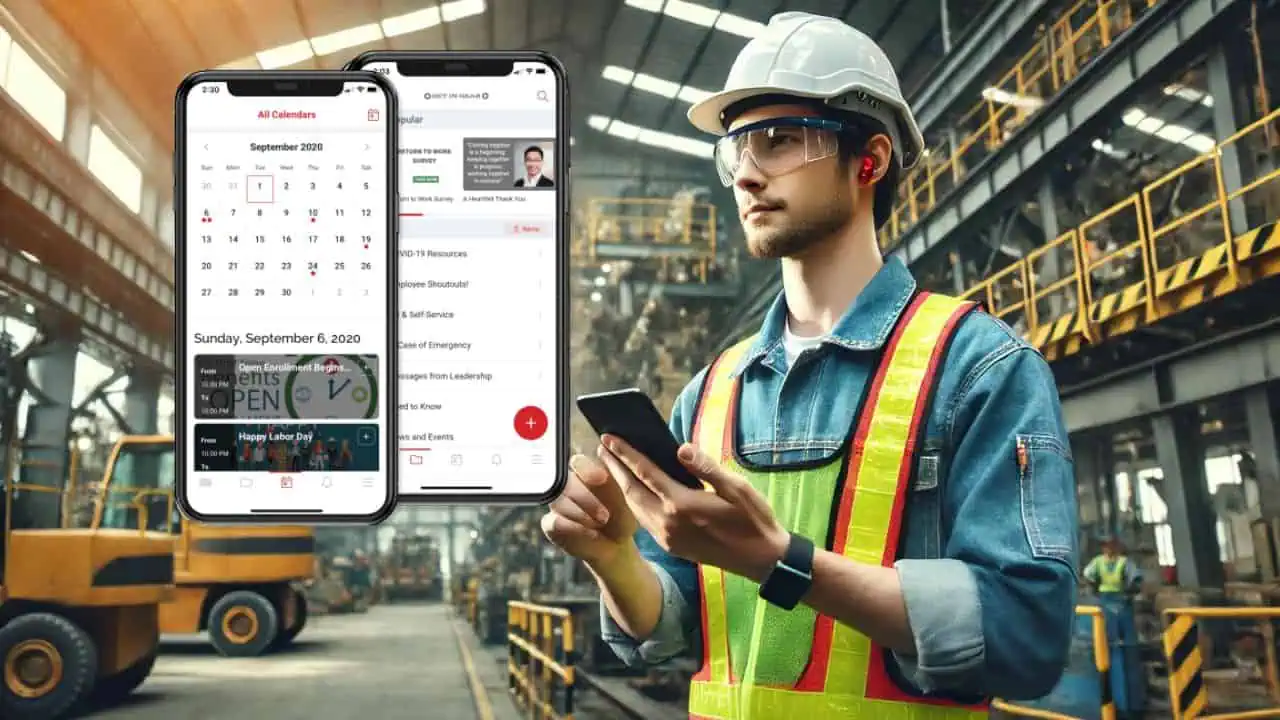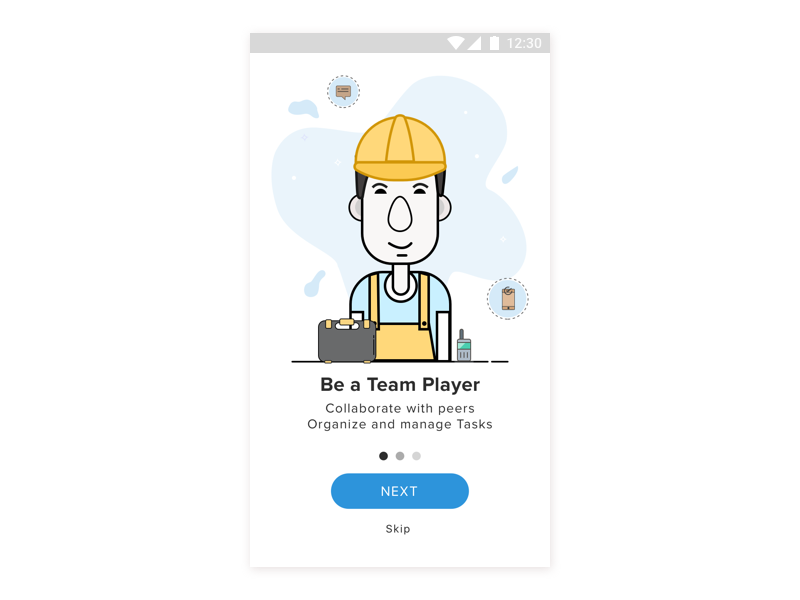Frontline workers, the unsung heroes of our communities, face unique challenges in their daily tasks. From healthcare professionals navigating complex patient care to retail staff managing busy stores, their efficiency and safety are paramount. This comprehensive exploration delves into the critical role a mobile app can play in empowering these vital individuals, streamlining workflows, and improving overall performance.
This discussion will cover the specific needs of different frontline worker roles, from healthcare to logistics, highlighting the essential features and functionalities required in a user-friendly mobile app. We’ll also explore the critical aspects of design, user experience, integration, and data management, ensuring the app is not only effective but also secure and compliant.
Defining the Need for Mobile Apps

The modern frontline is a battlefield of relentless demands. From the hushed corridors of hospitals to the bustling aisles of retail stores, and the labyrinthine networks of logistics hubs, workers grapple with a constant barrage of tasks, information, and urgent situations. A robust mobile app, meticulously designed, can be the critical difference between chaos and controlled efficiency.
The frontline worker, the unsung hero, bears the brunt of the operational burden. Their dedication fuels the engine of our daily lives, whether they’re administering vital care, stocking shelves, or coordinating complex supply chains. The right mobile application, crafted with a deep understanding of their needs, can transform their experience from a relentless struggle to a powerful instrument of progress.
Frontline Worker Roles and Challenges
Frontline workers encompass a vast spectrum of roles. Nurses, doctors, retail associates, delivery drivers, and warehouse personnel all operate on the very edge of the operational spectrum. Without effective tools, they face a deluge of challenges. Data entry errors, misplaced inventory, inefficient communication, and missed deadlines are just a few examples of the pitfalls that can derail the critical workflow. Time-sensitive information, vital to maintaining safety and operational standards, can get lost in the noise of paperwork, phone calls, and manual processes.
Impact on Efficiency and Productivity
Mobile apps, with their inherent capacity for automation and streamlined workflows, drastically improve efficiency and productivity. Real-time data access, task management, and collaborative tools transform mundane tasks into strategic actions. The ability to quickly access crucial patient information in a healthcare setting, or locate specific inventory in a retail environment, significantly shortens response times and improves customer service. These enhancements directly impact productivity, reducing errors and maximizing output.
Automated Tasks and Streamlined Workflows
Mobile apps can automate numerous tasks. Imagine a logistics app that automatically updates delivery schedules based on real-time traffic conditions, or a healthcare app that immediately notifies the appropriate personnel in case of an emergency. These apps can streamline complex workflows, reducing the time spent on manual processes. This efficiency translates into significant savings in both time and resources.
Communication and Collaboration in Frontline Work
Communication and collaboration are paramount in frontline work. Instantaneous communication between team members, immediate access to vital information, and the ability to share updates in real-time are essential for optimal performance. A mobile app facilitates this crucial communication, allowing frontline workers to stay informed, coordinate actions, and work together seamlessly.
Comparison of Frontline Worker Types and App Needs
| Worker Type | Key Challenges | App Needs |
|---|---|---|
| Healthcare | Time-sensitive patient information, rapid response protocols, and accurate record-keeping. | Secure data access, real-time communication tools, integration with electronic health records (EHR), and emergency notification systems. |
| Retail | Inventory management, customer service inquiries, and point-of-sale transactions. | Real-time inventory updates, customer relationship management (CRM) tools, mobile point-of-sale (POS) systems, and location-based services. |
| Logistics | Tracking shipments, managing deliveries, and coordinating with drivers. | Real-time tracking, route optimization tools, driver communication platforms, and order management systems. |
Mobile apps, when thoughtfully designed and implemented, represent a profound leap forward in the capabilities of frontline workers.
Features and Functionality
The digital frontier demands a response. Frontline workers, the unsung heroes of our world, deserve tools that empower, protect, and enhance their efficacy. A robust mobile application, designed with meticulous attention to detail, becomes their critical lifeline in the face of immediate challenges. This application must be more than a simple interface; it must be a strategic asset, providing unparalleled support and security.
This application is not just a collection of features; it is a system designed to elevate the performance of frontline workers, to empower their decisions, and to safeguard their well-being. Real-time data integration, coupled with secure communication protocols, creates a powerful synergy, enhancing safety, efficiency, and overall effectiveness.
Essential Features for Frontline Workers
Frontline workers operate in dynamic environments, demanding adaptability and immediate responsiveness. This necessitates a mobile application that prioritizes speed, clarity, and accessibility. The application must function seamlessly across diverse operational sectors, accommodating the unique needs of each field. Critical features should be intuitively designed and readily available to empower informed decisions.
- Real-Time Data Access and Updates: The ability to access critical information instantly is paramount. Imagine a paramedic receiving real-time patient data, enabling rapid, informed treatment decisions. This feature ensures that the application is not merely a repository of static information but a dynamic tool, reflecting the ever-changing realities of the field. This facilitates accurate and up-to-date data access, which is critical in emergencies or rapidly evolving situations.
- Safety and Security Enhancements: The application must be a shield, not a vulnerability. Built-in GPS tracking, emergency alerts, and secure communication channels are indispensable. A feature that allows for real-time location sharing with supervisors in emergencies is crucial for enhanced safety and security. The integration of biometric authentication further strengthens security, ensuring only authorized personnel access sensitive information.
- Secure Communication: Instantaneous and secure communication between frontline workers and supervisors is vital. Encrypted messaging, video conferencing, and secure file sharing are essential tools to facilitate collaboration, enabling swift decision-making and problem-solving. A system that prioritizes encrypted communication channels minimizes the risk of data breaches and unauthorized access to sensitive information.
- Decision-Support Tools: A mobile application must empower frontline workers with the necessary tools for informed decision-making. Algorithms and data visualizations can be integrated into the application to provide relevant information to assist workers in various situations. The application must contain pre-loaded protocols and guidelines that can be referenced in the field, offering a readily accessible library of information, thus ensuring consistent and informed actions.
Key Functionalities Across Sectors
The mobile application must be adaptable to the unique requirements of various sectors, ensuring its utility in diverse frontline environments. This adaptability ensures that the application is a valuable asset across various domains.
| Sector | Key Functionalities |
|---|---|
| Emergency Medical Services (EMS) | Real-time patient data, location tracking, secure communication with dispatch, pre-loaded emergency protocols. |
| Construction | Safety checklists, real-time equipment status, secure reporting of incidents, communication with site managers, location tracking for personnel. |
| Retail | Inventory management, real-time sales data, customer service support, secure payment processing, location tracking of personnel. |
| Public Safety | Incident reporting, real-time crime data, secure communication with headquarters, location tracking for officers, access to relevant legal information. |
Design and User Experience

The mobile app’s design dictates its fate. A poorly conceived interface can doom even the most innovative functionality. This section dives into the critical elements of crafting a user experience that empowers frontline workers, fostering seamless interaction and unparalleled efficiency. It’s not merely about aesthetics; it’s about creating a digital battlefield where every action is strategically deployed.
User Flow Diagram for a Typical Mobile App Task
A clear user flow diagram is paramount for understanding the app’s logic. This diagram visualizes the steps a user takes to accomplish a specific task, from initial access to the final outcome. A well-structured flow minimizes user friction, ensuring intuitive navigation and maximizing efficiency. The diagram should be comprehensive, illustrating all potential pathways, including error handling and alternative actions. This detailed roadmap ensures that the app’s functionality aligns seamlessly with the user’s workflow, streamlining the entire process.
Designing Intuitive Interfaces for Mobile Apps
Intuitive interfaces are critical for mobile apps. Frontline workers often operate in high-pressure situations, and the app must respond immediately and predictably. Using familiar patterns and icons, like those found in widely used mobile applications, helps to reduce the learning curve. This familiarity minimizes the cognitive load on the user, allowing them to focus on the task at hand. Avoid cluttered designs and unnecessary visual elements; keep the interface clean and uncluttered. Consistent use of typography and spacing creates a cohesive and professional aesthetic, further enhancing the user experience.
Importance of Mobile App Accessibility and Usability for Diverse Users
Accessibility and usability are crucial for inclusivity. Frontline workers come from diverse backgrounds and may have varying levels of technical proficiency. The app must accommodate users with different physical abilities, visual impairments, or cognitive differences. Designing with accessibility in mind not only meets legal requirements but also expands the potential user base and ensures inclusivity. Clear text sizes, sufficient color contrast, and support for screen readers are essential for a truly accessible experience. Usability testing with diverse users is essential for identifying and rectifying potential usability issues, ensuring the app is usable and practical.
Importance of a Consistent Design Language Across All App Features
A unified design language establishes a consistent and recognizable visual identity across all app features. This consistency creates a familiar and predictable user experience, enhancing overall usability. A consistent style guide should define elements such as typography, color palettes, and iconography, ensuring a unified visual aesthetic. This ensures the app feels coherent and reduces the user’s cognitive load, enhancing usability.
Examples of User Interface Design Patterns for Mobile Apps
Effective use of UI patterns streamlines the user experience. Patterns like the “hamburger menu” for navigation, “swipe-to-reveal” actions, and “card-based” layouts are proven effective in enhancing user engagement. Implementing these patterns ensures a familiar and intuitive experience, minimizing user confusion. Thorough research into current design trends and successful implementations provides insights into developing user-friendly interfaces.
Significance of Mobile App Performance and Responsiveness for Frontline Workers
Frontline workers need instant and reliable access to the information they need. The app must be responsive, loading data quickly and seamlessly adapting to various network conditions. Slow loading times and lag can be detrimental to the workflow, potentially leading to missed opportunities or critical errors. Optimization for various mobile devices, including different screen sizes and resolutions, is critical to maintaining a consistent user experience. Performance testing across different network conditions is essential for ensuring reliability.
Design Considerations for Various Screen Sizes and Devices
| Device Category | Screen Size | Design Considerations |
|---|---|---|
| Smartphones (Small) | 3.5-5.5 inches | Prioritize compact layouts, utilize icons effectively, and employ a single-column layout. |
| Smartphones (Medium) | 5.5-6.5 inches | Implement a two-column layout where possible, and leverage larger text sizes to improve readability. |
| Tablets | 7-10 inches | Utilize larger elements, supporting a more detailed interface, and allow for multi-tasking. |
This table highlights the importance of tailoring the design to various screen sizes. Mobile app design should be fluid and responsive, dynamically adapting to the user’s device, ensuring optimal usability and accessibility. This ensures the app remains usable and functional across a wide range of devices.
Integration and Data Management

The mobile app’s efficacy hinges on its seamless integration with existing systems, a critical component for streamlining operations and maximizing efficiency. A robust data management strategy, incorporating stringent security protocols, is paramount to safeguarding sensitive information and ensuring compliance with privacy regulations. This section Artikels the critical architecture for achieving this integration, emphasizing data integrity and user confidence.
Integration with Existing Systems
The app will leverage Application Programming Interfaces (APIs) to securely connect with various backend systems, including but not limited to, inventory management, CRM, and reporting platforms. This integration will facilitate real-time data exchange, ensuring all operations are synchronized and consistent across platforms. Direct connections to enterprise resource planning (ERP) systems are also crucial for optimizing data flow and eliminating data silos.
Security Measures
Protecting sensitive data is paramount. The app will utilize end-to-end encryption, multi-factor authentication, and role-based access controls to safeguard information from unauthorized access. Regular security audits and penetration testing will ensure the ongoing robustness of the system. Data encryption will be implemented both in transit and at rest. This includes employing industry-standard encryption algorithms like AES-256.
Data Privacy and Compliance
Adherence to stringent data privacy regulations, such as GDPR and HIPAA, is non-negotiable. The app’s design will incorporate anonymization and pseudonymization techniques where appropriate. Data retention policies will be clearly defined and meticulously followed, ensuring compliance with legal and regulatory mandates. All data collection and usage will be transparent to the user, allowing them to understand how their data is handled.
Data Formats for Effective Transfer and Storage
Standardized data formats, such as JSON and XML, will be employed for seamless data exchange between the mobile app and backend systems. This ensures compatibility and reduces potential data transformation issues. The choice of format will depend on the specific data requirements and the architecture of the integrated systems. JSON’s human readability and ease of parsing make it an ideal choice for many applications.
Data Points to be Collected and Analyzed
The app will collect various data points, crucial for performance analysis and strategic decision-making. These data points include task completion times, resource utilization, incident reports, and user feedback. Comprehensive data collection will enable detailed insights into workflow efficiency and identify areas requiring optimization. Data points will be carefully selected to avoid data overload and ensure meaningful analysis. The key is to collect the necessary data without overburdening the system or the user.
Data Sources Integrated with the Mobile App
| Data Source | Data Point Example | Purpose |
|---|---|---|
| Incident Management System | Incident type, location, description, resolution time | Real-time incident tracking, resource allocation, and performance analysis. |
| Inventory Management System | Stock levels, item locations, requisition details | Real-time inventory tracking, optimizing stock management, and reducing downtime. |
| Employee Database | Employee location, role, contact information | Efficiently assigning tasks and tracking employee performance. |
| Reporting Platform | Key performance indicators (KPIs), statistical summaries | Data visualization, reporting, and decision support. |
Case Studies and Examples

The digital battlefield demands relentless innovation. Frontline workers, often operating in high-stakes environments, deserve tools that empower them, not encumber them. Real-world case studies reveal the transformative potential of mobile applications, showcasing how optimized workflows, improved safety protocols, and enhanced communication systems can drastically reshape operational efficiency.
Mobile apps are no longer a futuristic fantasy; they are the vanguard of operational excellence. These applications, strategically designed and meticulously implemented, have proven to dramatically improve productivity, worker satisfaction, and overall operational efficiency across diverse sectors. The success stories, detailed below, illuminate the profound impact these tools can have in real-world scenarios.
Real-World Applications of Mobile Apps
Mobile applications are proving to be more than just convenient tools; they are strategic assets, transforming how frontline workers execute their tasks. From dispatching paramedics to tracking equipment maintenance, the applications offer a dynamic platform for real-time data management. This allows for immediate responses to critical events and streamlined procedures, leading to significantly improved operational efficiency.
Successful Implementations in Various Sectors
Numerous sectors have recognized the transformative potential of mobile applications. The healthcare industry, for instance, has seen dramatic improvements in patient care through real-time access to patient information and streamlined communication channels. Construction companies have witnessed increased safety measures and reduced errors through mobile apps that track equipment maintenance and worker location. In the transportation sector, mobile applications are facilitating the optimization of delivery routes and enhancing driver safety.
Positive Impact on Worker Productivity and Satisfaction
“Increased productivity is a direct result of optimized workflows and streamlined processes.”
Studies consistently show that mobile applications designed with user experience in mind lead to a marked improvement in worker productivity. Frontline workers report enhanced job satisfaction through the empowerment and control offered by these intuitive tools. Empowered by real-time information and streamlined procedures, workers can concentrate on their core tasks, leading to a substantial improvement in their overall job satisfaction.
Improved Safety Measures and Reduced Errors
Mobile applications offer a dynamic platform for implementing proactive safety measures. The applications often include features like real-time location tracking, emergency alert systems, and compliance checks, which significantly reduce risks. Moreover, these applications can mitigate errors by providing instant access to relevant information, detailed procedures, and safety protocols.
Lessons Learned from Previous Implementations
The journey toward effective mobile app implementation is not without its challenges. Previous implementations have revealed critical lessons. A common pitfall has been a lack of user-centered design. Successful applications prioritize the needs and workflows of frontline workers, ensuring the tools are intuitive and easy to use in high-pressure situations. Thorough testing and feedback loops are crucial to identify and address usability issues early in the development process.
Comparative Analysis of Case Studies
| Case Study | Sector | Key Takeaways |
|---|---|---|
| Emergency Medical Services (EMS) | Healthcare | Improved response times, enhanced communication, and increased patient safety. |
| Construction | Infrastructure | Reduced accidents, improved safety protocols, and increased productivity. |
| Logistics and Delivery | Transportation | Optimized delivery routes, improved driver safety, and real-time tracking of packages. |
Technical Considerations

The digital fortress of this frontline worker app demands meticulous engineering. This is not a casual application; it’s a lifeline, a shield against the unknown. Robust design and unwavering security are paramount. The code must be as impenetrable as the very tasks these workers face.
Platform Choices
The app must be accessible across a spectrum of devices. The choice of platform is critical, demanding a balance between native performance and widespread reach. Native applications for iOS and Android provide the optimal user experience, ensuring responsiveness and a seamless integration with device features. However, cross-platform development allows for quicker deployment and reduced development costs. A thoughtful analysis of user base demographics and device prevalence will guide the decision. The best solution is often a hybrid approach, leveraging the strengths of both strategies.
Development Tools and Technologies
Selecting the right tools is essential. The development team will leverage a combination of established and emerging technologies to craft a sophisticated, resilient application. This may include modern programming languages like Kotlin or Swift, coupled with robust frameworks like React Native or Flutter for cross-platform development. These choices will dictate the app’s performance, scalability, and long-term maintainability. The goal is to create a system that is not only functional today but also future-proof.
Security Protocols and Data Encryption
Security is non-negotiable. The app must incorporate industry-standard security protocols to safeguard sensitive data. This includes end-to-end encryption for all user communications and data transmission. Data at rest must be encrypted using robust algorithms, preventing unauthorized access. Regular security audits and penetration testing are vital to maintain the app’s integrity and to ensure the protection of both personal and organizational information. This requires a proactive and evolving security strategy.
Maintenance and Support Strategies
The app’s journey doesn’t end with deployment. Ongoing maintenance and support are critical for a long-term solution. A comprehensive support strategy, including a dedicated support team and a user-friendly help center, is essential for addressing user queries and issues. A robust bug tracking system will be instrumental in managing and resolving any defects or malfunctions promptly. Regular updates and feature enhancements will ensure the app remains aligned with evolving needs and user expectations.
Technical Specifications and Requirements
| Category | Specification |
|---|---|
| Operating Systems | iOS 15+ and Android 11+ |
| Programming Languages | Kotlin/Java for Android, Swift/Objective-C for iOS, potentially JavaScript for cross-platform elements |
| Development Frameworks | React Native, Flutter, or native solutions |
| Data Storage | Secure cloud database with encrypted storage; local storage for offline access |
| Security Protocols | HTTPS, TLS 1.3; end-to-end encryption |
| Performance | Responsive UI, optimized for low bandwidth environments |
| Scalability | Capacity to handle anticipated future user growth |
Last Point
In conclusion, a well-designed mobile app for frontline workers can revolutionize their daily tasks, fostering improved efficiency, enhanced safety, and increased job satisfaction. By streamlining communication, automating processes, and providing real-time data access, these apps empower workers to perform their duties more effectively. Ultimately, this exploration underscores the potential of technology to support and elevate the crucial work of frontline heroes.





